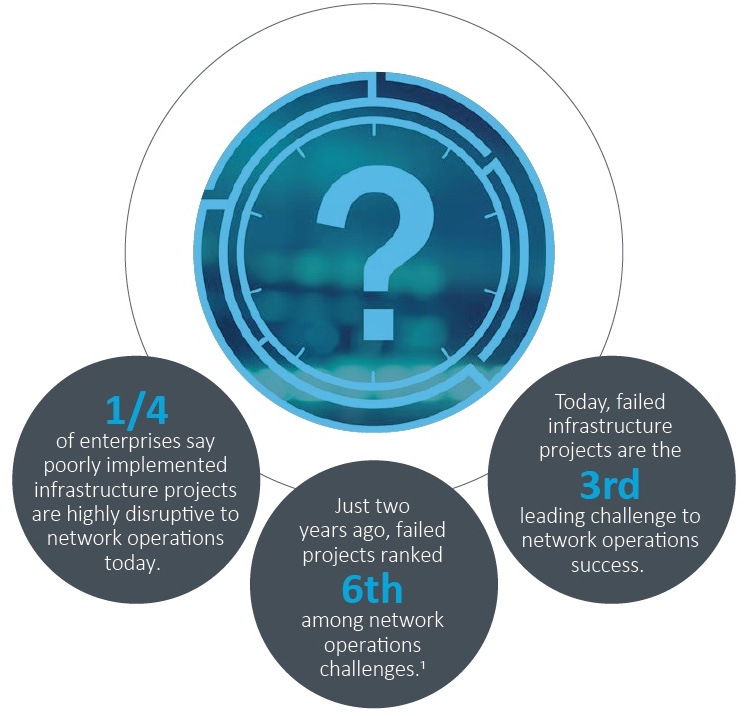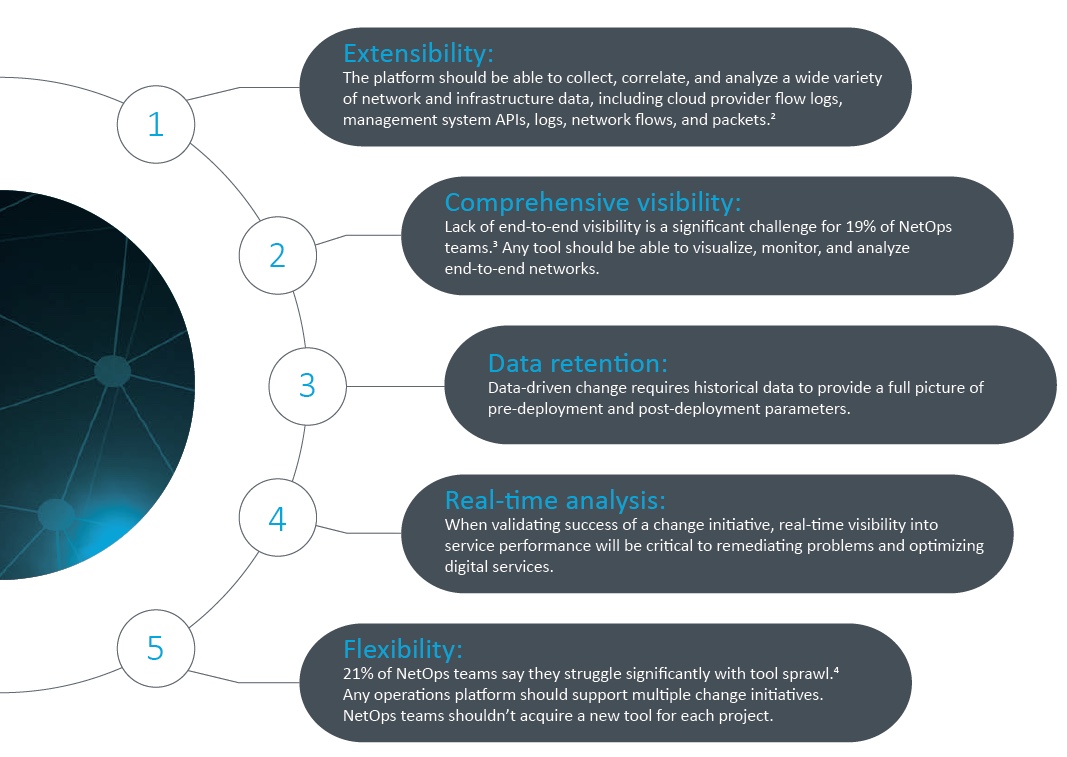Contents
Finding a Network Performance Management Platform (NPM) with the right capabilities can make the difference in a successful digital transformation.
This eBook explores:
- The 5 characteristics to look for in an NPM platform
- The 3 steps to follow for any major network change
- Detailed information on effective change management for
- Application rollouts
- Cloud migration
- SD-WAN transformation
Make your network health a competitive differentiator in your digital transformation. LiveAction has the tools to monitor complete network traffic (including encrypted) and to detect and alert you to network irregularities. Try it out today.
Poor Planning Leads to Failed Change
Poor planning of new digital initiatives can damage the overall success of an enterprise. It also places a heavy burden on network operations teams, who are tasked with supporting poorly planned transformation.

1 EMA, “Network Management Megatrends 2020,” April 2020.
Ensure Success by Enabling Data-Driven Change Initiatives
NetOps Teams Have an Opportunity to Lead
The network is essential to any digital initiative, and any change to digital services will impact that network.
With an effective network performance management (NPM) platform, network operations teams can provide guidance for planning, implementing, and validating a change to digital services. This platform will also support ongoing optimization and management of digital infrastructure.
You Need the Right Tool to Manage Change
A NPM platform must have the following characteristics to support data-driven change management.

2 EMA, “Network Management Megatrends 2020,” April 2020.
3 Ibid.
4 Ibid.
How to Lead Data-Driven Change with Network Performance Management
Baseline existing services
Network managers should use their NPM platform to identify service dependencies, map traffic patterns and user behavior, and establish basic capacity requirements for the existing service.
Guide implementation of new services
Leveraging the power of a modern NPM platform, the network operations team can generate and share reports on baselined services with the implementation team. These reports should review the anticipated capacity requirements of a service. With insight into traffic patterns and user behavior, network managers can also design security, compliance, and quality of service policies for the new technology.
Validate implementation
Network managers can monitor and analyze service performance after data-driven change has been implemented. With a modern NPM platform, they can validate policy compliance and assure that the new service has sufficient capacity over time.
Examples of Data-Driven Change Management
New Application Rollout
Prepare for Supporting Application Rollout
The network operations team should identify the infrastructure that will support a new application before the rollout begins. Then, they should ensure that their tools can provide sufficient visibility into this application environment.
Pre-Rollout
Network managers should identify a comparable application, either a legacy application that the new one will replace or an application used by a similar group of users. They should baseline traffic generated by this comparable application. At this stage, they should also understand network performance impacts on the application and network traffic patterns.
Deployment
The network operations team should generate reports for DevOps to help them optimize application design for the network and optimize application infrastructure based on network conditions.
They should also use capacity baselines and traffic analysis to implement necessary changes on the network, such as new firewall rules and quality of service tiers.
Post-Rollout
Network managers must monitor real-time network traffic with application insight to track application
performance in the data center or cloud and monitor end-user experience. This visibility will guide ongoing infrastructure optimization.
Cloud Migration
Prepare for Cloud Operations
Unfortunately, 61% of network operations professionals say their NPM tools provide inferior visibility into the public cloud.5 Network managers should assess the cloud monitoring capabilities of their NPM platforms before any cloud migration begins.
Pre-Migration
Network managers should measure the capacity requirements of an application in its legacy environment. Measure these requirements over time to discover any trends and to project long-term network requirements.
This is also the time to determine dependencies and user access patterns. NPM tools should reveal how the application interacts with other applications and services in the enterprise. User access patterns will help shape access policies.
The network operations teams should understand user expectations for the application by baselining performance in the legacy environment. Use this insight to set goals for post- migration performance and latency.
Deployment
As an application migrates to the cloud, network managers must validate the high-availability architecture in the cloud. An NPM platform can reveal whether load balancing and other application delivery services are properly configured. It can also verify compliance with security and access policies and reveal whether any legitimate traffic will be rejected by security controls.
Post-Migration
Once the application has completed its move to the cloud, the network operations team should monitor application experience from the user’s perspective using on-premises and remote user monitoring capabilities.
5 EMA, “Network Management Megatrends 2020,” April 2020
SD-WAN Transformation
Prepare for SD-WAN Operations
Today’s software-defined wide-area network (SD-WAN) solutions provide good native visibility into network overlays, but they often lack visibility into end-to-end WAN performance. Third-party NPM platforms are required for full visibility. Before selecting an SD-WAN vendor, network managers should verify that their NPM platform has adequate visibility into the SD-WAN solution.
Pre-Migration
An NPM platform can measure capacity requirements of the existing WAN. This includes a comprehensive analysis of site-to-site, site-to-data center, and site-to-cloud bandwidth consumption. At this stage, network operations teams should also identify critical applications traversing the WAN, measure their current performance, and baseline user experience expectations.
Deployment
The network operations team should verify that the new SD-WAN solution will provide sufficient hybrid WAN capacity across the network. In most cases, enterprises will transition from an all-MPLS network to a hybrid network of MPLS and internet connectivity. The team should verify that total bandwidth on this new network will meet the capacity requirements across all network paths. At this time, the team should also verify that applications are receiving appropriate quality of service priority.
Post-Migration
Once the SD-WAN solution has been implemented, network managers must monitor the health and performance of hybrid connectivity and verify that the path-steering features of SD-WAN are sending traffic over the best available link. Poorly configured path- steering features will degrade user experience. Use this visibility to optimize SD-WAN configuration.
Seize This Opportunity

Digital transformation is driving change in many ways, leading enterprises to deploy new applications, expand into multi-cloud architecture, and adopt new network infrastructure. The network can be a competitive differentiator for these digital initiatives.
The network operations team has the opportunity to lead. As change appears on the horizon, network managers must assess the readiness of their NPM platforms. Then, they must insert themselves in the project as enthusiastic partners for data-driven change by showing project managers what their NPM platforms can do.
Network managers should grab a seat at the table. Otherwise, they will suffer later. It’s always the network’s fault when digital services fail, even if the team that implemented change is at fault. Network operations will be expected to solve the problem or prove its innocence. Thus, network managers should use their operational visibility and insight to ensure change is successful. They must lead as early as possible to make sure that any change to digital services is data-driven.
Download eBook
Digital Transformation Requires Data-Driven Change with a Network Performance Management Platform
Download Your Free LiveNX Trial
About LiveAction®
LiveAction provides end-to-end visibility of network and application performance from a single pane of glass. We provide enterprises with confidence that the network is meeting business objectives, full network visibility for better decisions, and reduced cost to operate the network.




